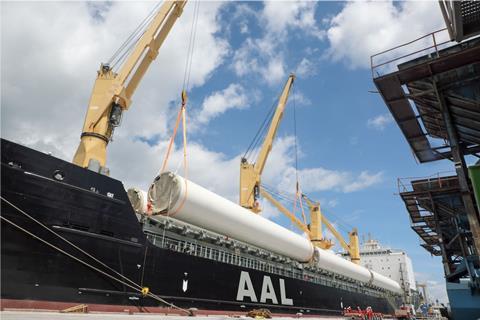Miners in Australia are increasingly installing renewable energy sources to cut their net carbon emissions, creating work for heavy lift and multipurpose carriers.

The mining sector has an important role to play in the quest for a better environmental balance in industrial processes. The focus has been on reducing Scope 1 and 2 emissions. Increasingly, mining houses are developing green energy infrastructure to supply their own activities, opening up new potential customers for project logisticians.
For instance, across multiple remote locations in Western Australia, mine sites are integrating renewable sources to reduce the carbon intensity of their activities. In the Northern Goldfields region, the Jundee, Bellevue and Kathleen Valley mines are developing hybrid facilities that combine wind and solar energy, gas-fired plants and battery storage systems.
The largest of these facilities in the Australian resources sector, however, is a 116 MW hybrid plant at the Tropicana gold mine. For this project, multipurpose and project heavy lift carrier AAL Shipping was tasked with delivering a shipment of wind turbine components.
The Tropicana gold mine is situated 330 km northeast of Kalgoorlie in remote Western Australia. Its owner is integrating 62 MW of clean energy into the existing 54 MW gas-fired power system at the site.
The integration of renewables into the power system will see a 24 MW solar farm, a 14 MW battery storage system (BESS) and four 6 MW wind turbines developed at the mine.
Andrew Mangan, chartering manager at AAL Shipping Australasia, commented: “While renewable energy development has had a strong presence on the east coast of Australia for some years, the west coast is still an emerging market for this green energy resource.
“For instance, mining operations like the Tropicana gold mine are looking to give themselves a more sustainable modus operandi, and this will include the realisation of renewable energy at their sites.”
To support that goal, AAL completed a full charter operation to transport the wind energy components on a dedicated sailing from Taicang, China, to Geraldton, Australia. Using a chartered-in vessel from its worldwide fleet, AAL was responsible for the transport of 12 blades, measuring over 80 m long; tower sections; and four generators that weighed 127 tonnes each. In total, the shipment comprised 82 packages.
Planning for the project began in December last year, with the transport starting in April and finishing in May. With the components delivered to Geraldton, they will begin the more than 1,200 km journey to the project site – believed to be the longest inland journey of wind turbine blades in Australia.
Once installed along with the solar farm and BESS, the plant is expected to be one of the largest hybrid facilities in the Australian resources sector.
As companies in the mining sector look to strengthen their environmental credentials, projects such as these will continue to provide opportunities for the project logistics and heavy transport market. From its Australian hub office in Brisbane, where AAL started operations nearly 30 years ago, the company continues to provide scheduled monthly breakbulk and project/heavy lift liner services that connect the country’s east and west coasts with key trading markets across Asia.
















